A) A
B) B
C) C
D) D
F) B) and C)
Correct Answer

verified
Correct Answer
verified
Multiple Choice
When a river enters a lake or an ocean, it slows down, losing its capacity to carry sediments, forming:
A) deltas
B) point bars
C) cutbanks
D) meanders
E) oxbow lakes
G) A) and C)
Correct Answer

verified
Correct Answer
verified
Multiple Choice
Narrow canyons are formed when:
A) downward incision is faster than widening of the canyon by erosion
B) downward incision is slower than widening of the canyon by erosion
C) erosion widens the canyon before the downward incision begins
E) All of the above
Correct Answer

verified
Correct Answer
verified
Multiple Choice
What type of feature is shown in this figure? 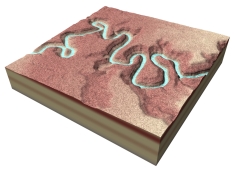
A) a braided stream
B) river terraces
C) alluvial fans
D) entrenched meanders
E) none of these
G) D) and E)
Correct Answer

verified
Correct Answer
verified
Multiple Choice
Which of the following profiles does NOT match its position on the stream? 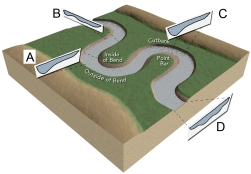
A) A
B) B
C) C
D) D
F) B) and C)
Correct Answer

verified
Correct Answer
verified
Multiple Choice
Which of the following features is most related to erosion along a low-gradient stream?
A) point bar
B) floodplain
C) levee
D) none of these
F) A) and C)
Correct Answer

verified
Correct Answer
verified
Multiple Choice
Which of the features on this aerial photograph represents the former position of a meander? 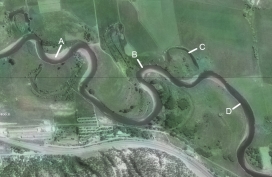
A) A
B) B
C) C
D) D
E) both C and D
G) B) and E)
Correct Answer

verified
Correct Answer
verified
Multiple Choice
Stream terraces represent:
A) older floodplains of a river that has incised downward
B) cutoff meanders of a meandering stream
C) areas where sea level has risen and waves beveled across the coast
D) none of these
F) B) and C)
Correct Answer

verified
Correct Answer
verified
Multiple Choice
Which of the following is the main reason that a delta forms when a stream flows into a lake or sea?
A) the stream flows backward during high tide
B) ocean waves push the sediment up onto the beach
C) the velocity of the stream decreases
D) the stream began downcutting during the ice ages
E) none of these
G) A) and E)
Correct Answer

verified
C
Correct Answer
verified
Multiple Choice
What does a profile of a river from its headwaters to its mouth typically show?
A) an increase in gradient downstream
B) a straight-line profile reflecting a constant decrease in gradient
C) an abrupt increase followed by a gradual decrease
D) a curved shape that flattens out downstream
E) none of these
G) A) and E)
Correct Answer

verified
Correct Answer
verified
Multiple Choice
Which of the following can have a significant effect on a river?
A) rises and drops in sea level
B) tectonics
C) types of bedrock in the river
D) changes in climate
E) all of these
G) A) and E)
Correct Answer

verified
Correct Answer
verified
Multiple Choice
Which of the features on this aerial photograph is an oxbow lake? 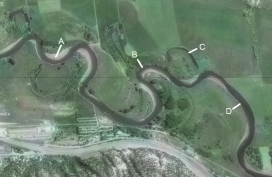
A) A
B) B
C) C
D) D
F) B) and D)
Correct Answer

verified
Correct Answer
verified
Multiple Choice
When conditions such as climate remain stable, a stream may approach a dynamic equilibrium state. The stream would then be considered:
A) a graded stream
B) a progressive stream
C) a tributary
E) A) and C)
Correct Answer

verified
Correct Answer
verified
Multiple Choice
On this graph of discharge versus season for a river in the Rocky Mountains, why is the highest runoff likely to be in the spring? 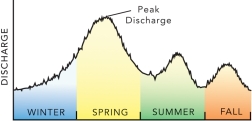
A) winter snow melts in the spring
B) the Rocky Mountains have many tornadoes during the spring
C) the Rocky Mountains experience hurricanes in the spring
D) all of these
F) B) and C)
Correct Answer

verified
Correct Answer
verified
Multiple Choice
What are some effects of building a dam?
A) a stream has more sediment below the dam and so can erode more efficiently
B) the reservoir lake) traps sediment that over time fills up part of the reservoir
C) a dam, whether constructed by nature or by humans, represents a permanent change in base level
D) the stream erodes into the land instead of depositing sediment, where it enters the reservoir
F) A) and C)
Correct Answer

verified
B
Correct Answer
verified
Multiple Choice
The cross-sectional area of the channel of a stream or river is calculated by:
A) multiplying the channel's width by its average depth
B) multiplying the channel's depth by its average length
C) dividing the channel's depth by its width
D) adding the channel's width and average length
F) A) and C)
Correct Answer

verified
Correct Answer
verified
Multiple Choice
What is a braided stream?
A) A stream that flows in a network of many interconnected rivulets around numerous bars
B) A stream with pronounced sinuous curves
C) A stream that exhibits a delicate balance between its transporting capacity and the sediment load available to it
E) A) and C)
Correct Answer

verified
Correct Answer
verified
Multiple Choice
What happens to the erosive power of a stream as velocity increases?
A) Erosion increases.
B) Erosion decreases
C) Erosion is not related to velocity.
E) None of the above
Correct Answer

verified
Correct Answer
verified
Multiple Choice
If a stream-cut canyon is deep and narrow, which of the following is most likely to be true?
A) rocks in the canyon walls are relatively hard and so easy to erode
B) the stream is probably close to its base level
C) downcutting is occurring faster than widening
D) the stream contains mostly small clasts, such as silt
F) A) and C)
Correct Answer

verified
C
Correct Answer
verified
Multiple Choice
A stream cannot erode below:
A) sea level
B) its headwaters
C) its channel
D) its bedrock
E) its tributaries
G) A) and B)
Correct Answer

verified
Correct Answer
verified
Showing 1 - 20 of 137
Related Exams